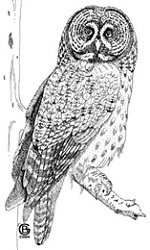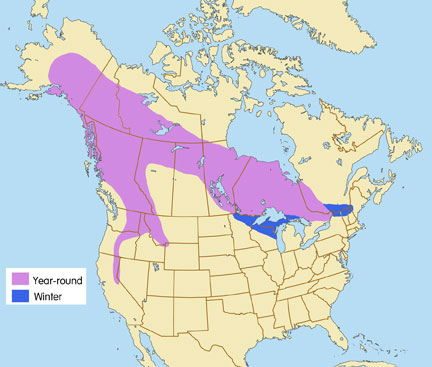
Scientific Name: Strix nebulosa
The tallest and one of the largest owls in North America, the Great Gray Owl can be recognized by the large head with a prominent facial disk that lacks ear tufts. The facial disk is grayish white with distinct concentric, semicircular bars of brown. The “eyebrows,” lores, and chin can be grayish white, giving the bird a white “moustache” that is broken by a black “bowtie” in the middle. The sexes are alike with the female larger and sometimes darker. Upperparts are grayish brown, broken by grayish white flecks and bars. The tail is very long, wedge-shaped, and dusky gray with nine bands. The wings are broad and the toes are short and heavily feathered. Despite its large appearance, the Great Gray Owl is 15% smaller than the Great Horned Owl (Bubo virginianus), with the bulk of the Great Gray Owl made up of feathers (perhaps to survive in the cold climates it inhabits). Eyes are yellow and appear small due to the large facial disk. Flight has been described as slow and effortless, much like a moth. However, they are capable of great bursts of speed.
Male
Length: 52″ ave.
Wingspan: 32 – 35″
Weight: 1.5 – 2.6 lb.
Female
Length: 52″ ave.
Wingspan: 33.8 – 36.6″
Weight: 2.0 – 3.7 lb.
The Great Gray Owl is both federally and state protected and is considered a sensitive species. Suitable habitat is negatively effected by logging and clear cutting in many areas. Forest fire suppression limits the number of suitable nesting sites (large open snags), limiting population density. Rodenticides used in grazing areas decimates prey base for the Great Gray Owl.
These owls prefer subalpine coniferous forests through dense boreal and montane coniferous forests. In the Sierra Nevadas of California, mixed conifer forests and red firs at high elevations are preferred. In all cases, forests are chosen when they border open spaces such as meadows, marshes or bogs where the owls prefer to hunt rodents. Trees are used for nesting and roosting with the bird close to the trunk for camouflage. During winter the birds may move out of the forest to more open fields for better hunting success.
These rodent specialists usually take small rodents up to 100 grams (3.5 ounces) as prey. Some 80-90% of their diet may be made up of small rodents (voles, mice, gophers and shrews most important), with a much smaller percentage being larger mammals and birds. Usually this bird hunts early in the morning and again in the late afternoon and near dusk, with modified daytime hunting during the short winter days. The male will hunt more diurnally during breeding season when he is supplying the female and chicks with food. Hunting usually takes place from perches where the owl listens and watches for prey. Once a prey has been located the bird will make a short stoop to the location of the prey. They rarely hunt while flying. Like other owls, the Great Gray has excellent hearing and can locate prey by acoustic cues alone. Large, asymmetrical ear openings allow them to precisely locate prey. Live prey is detected under snow cover and using their clenched feet, the birds break through the snow as much as 45 cm (17 inches) to grab the prey with their feet. These birds are able to break through an icy crust on snow which could support the weight of an 80 kg (176 lb) human. During the summer they might use the same technique to break into mammal burrows. Due to the size of their prey, Great Gray Owls rarely directly compete with larger owls such as the Great Horned Owl, who selects much larger prey.
Deliberate series of soft and low pitched single or double syllable hoots that gradually drop in frequency and decelerate towards the end of the call. Usually used during breeding season and for territorial disputes, but some populations can be heard calling year round.
Pairs usually begin nesting in March with nesting peaking in mid-April and late May. Pair bonds appear to be monogamous but unknown in duration or if the birds remain together outside of breeding season. They compete with other raptors such as the American Goshawk for nesting sites, and breeding density depends on nest site and prey availability. Nests are often old raptor or corvid nests or broken top snags. No nest modification is done by the pair except the female will sometimes make an impression in the bottom of the nest before laying eggs. Pairs will use man-made nest structures and have shown good nest success at those sites. 2-5 eggs are laid, with the female doing the incubating and the male hunting for prey. The eggs hatch at approximately 29 days and the young are independent at about 4-5 months. Mortality of the young is high, with Ravens (Corvus corax) taking eggs, and Great Horned Owls preying on young birds.
Collisions with motor vehicles is the greatest cause of mortality in Great Gray Owls. They are also shot, collide with barbed wire and are electrocuted on transmission lines. As with many other birds of prey, habitat loss and fragmentation is the greatest risk to the overall survival of the species.

During the breeding season the Great Gray Owl is found from central Alaska, northern Yukon, northern Mackenzie, northern Manitoba, northern Ontario south in the interior along the Cascade Mountains and Sierra Nevada Mountains to central California, and in the Rocky Mountains from northern Idaho and Montana to western Wyoming. Some individuals are found in far northern Minnesota and rarely in northern Wisconsin and Michigan. This species usually winters in its breeding range but wanders south to Montana, North Dakota, southern Minnesota, southern Wisconsin and central Michigan. Some individuals at high elevations may move to lower elevations to avoid heavy snow during the winter. Great Gray Owls are irregularly irruptive, with periodic invasions into various northern states. A combination of high reproductive rates the year before followed by a winter prey decline has been thought to explain these movements. Perhaps the accumulation of icy crusts on the snow cover will also drive some individuals further south. It is mostly young birds that make up the irruptions to the south. These irruptions happen in different regions in different years, suggesting that local prey availability drive these movements.
Special Thanks for range maps:
Dan Gleason
BGleason Design & Illustration
Commercial & Scientific Illustration, Graphic Design
CraneDance Communications
Book Production/Design

